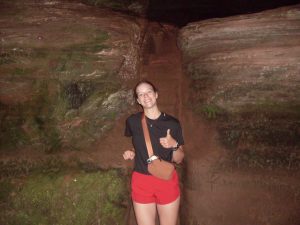
Me in Hocking Hills!
Hello! My name is Rylea Gist, and I am a sophomore at OWU. I am majoring in environmental science and biology.
Before reading Chapter One of Nadine Schuurman’s GIS: A Short Introduction, I only vaguely knew what GIS was and how widespread it was. I thought it was used primarily by farmers and scientists to study the geographical makeup of specific areas. After reading the chapter, I realized how much of my daily life is rooted in GIS, from deciding the route to specific locations to visualizing consumer data to determine the price of goods. I was super interested in the origins of GIS as well. I would never have imagined that the roots of GIS came from meticulously drawn maps layered together over a lightbox. It is crazy how quickly GIS has grown, from having to be hand-drawn and layered to now being able to put data into a computer to create the maps for you. Logically, it makes sense how and why GIS has developed, considering that humans are such visual learners, as well as the need to consider a variety of different topics at the same time. Combining several maps and seeing a pattern is much easier than looking strictly at numerical data. I also found it interesting that some scientists entirely relied on the maps created by GIS to be complete facts.
In contrast, others were more hesitant and had to ask more scientific questions about the data, its origin, and its effectiveness in different situations. This idea reminded me of my statistics class in high school, where we had to be highly cautious in reading and interpreting statistics because so many areas could be flawed. I wonder how using biased data could create a biased result and what the implications are for society. Overall, this chapter is exciting, and it excites me to keep learning about GIS and see what I can do with it in the future.

The first GIS application I found was an American scientist using GIS to track feral cats on New Zealand’s Auckland Island. These cats are not native to the island, and therefore, they are destroying the biodiversity. The goal is to locate and eradicate the feral cats, restore the island to its natural state, and let the native flora grow. She uses GIS to map the location of cats in conjunction with bird populations to develop a strategy to remove the cats. She also uses GIS to determine population density and the best places for helicopters to place bait.
Keywords: GIS Application Stray Cats

The following GIS application is to save monarch butterflies. The Rights-of-Way as Habitat Working Group combines data from various organizations with GIS. This data will help to visualize habitat locations and support these organizations in determining where to plant more milkweed to help the monarch butterfly population. This is so important because it is estimated that monarch butterflies are going to need 5x more milkweed to survive, so this data helps to show exactly where the milkweed should be planted to best impact the butterfly population
Keywords: GIS Applications Monarch Butterflies